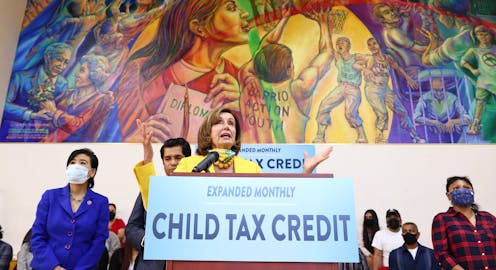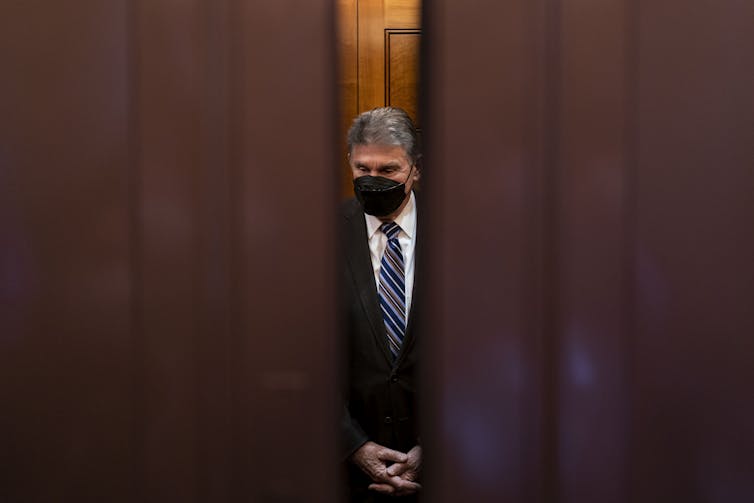
The Build Back Better bill, the centerpiece of the Biden administration’s domestic policy, cleared the House of Representatives by a slender margin largely along party lines in November 2021.
Legislative progress came to a sudden stop a month later when Sen. Joe Manchin announced, in a Fox News interview, that he would not support it. Without the West Virginian’s vote, Senate Democrats lacked the majority they needed to pass the bill.
Manchin raised concerns about inflation and objected to several of the measure’s energy provisions. He also had qualms about a program that had been temporarily helping, according to one estimate, over 90% of the children in his state: the expansion of the child tax credit.
As far back as the Nixon administration, the federal government’s efforts to give low-income families financial assistance have repeatedly sparked the same debate: How can the government, at a reasonable cost, provide adequate benefits for children in need and strong work incentives for their parents or guardians?
Solving this problem, as I observed long ago as a graduate student studying the Nixon plan and a similar one debated in the United Kingdom in the 1970s, depends more on political calculations than on economic analysis.
A 1-year trial run
The Biden administration’s $1.9 billion COVID-19 relief bill, which Congress passed in March 2021, included a single-year expansion of the child tax credit.
This benefit for families with children originated with a tax package Congress passed in 1997. Lawmakers subsequently modified it several times, often with bipartisan support. Prior to 2021, the most recent update was part of former President Donald Trump’s 2017 tax reform package.
Biden’s version gave most U.S. families a credit against taxes of $3,000 for each child from age 6 to 17, and $3,600 for those younger than 6. Lower-income families could obtain this credit as six monthly cash payments from July to December, reserving the rest of the money for a lump sum at tax time in 2022. The monthly payments ceased in January 2022.
Previously, the credit was delivered at tax time only and maxed out at $2,000 per child. Families with very low incomes, but not those without any earnings at all, were eligible only for up to $1,400 in payments. A big change in 2021 was that even parents without any earnings, who therefore owed no taxes, could get the maximum benefit.
This change alone, Columbia University researchers estimated, reduced the number of children in poverty by 25% after payments began in July. That research team predicted that greater declines would be likely once more families claimed their benefits.
The Build Back Better bill would have extended the child tax credit expansion for another year. But Manchin, along with many Republicans, said he believed the Biden administration’s real goal was to make it permanent – a goal of many Democrats in Congress.
Conservatives viewed the long-term adoption of a more generous child tax credit, which would cost an estimated $1.6 trillion over 10 years, according to the Congressional Budget Office’s calculations, as too expensive. They also feared that it might reduce employment among low-income families, even though social policy experts disagree on the extent to which that would happen.
Republican lawmakers have generally favored a more targeted approach that would restrict payments to the low-income families that needed them most and had at least some earnings. They were unwilling to let go of the system adopted in 1997, which prioritizes work incentives over helping the neediest families.

Competing priorities
A version of that system was in effect until 2021 and is again in place for the 2022 tax year. It did not allow families with less than $2,500 in earnings to receive any portion of the child tax credit as a payment and then no more than $1,400, if eligible.
Before Biden’s COVID-19 relief bill, higher-earning families could still use the credit of $2,000 per child to lower their taxes until their incomes reached the $200,000 mark for single parents and $400,000 for married couples with children, at which point the credit phased out.
By contrast, the Biden administration’s version provided its larger tax credit not only to low-income families but also to those with modified adjusted gross income above $75,000 for single filers, $112,500 for head-of-household filers and $150,000 for married couples filing a joint return. Above those amounts, it reverted to the previous version until it phased out entirely.
If a program gives more generous help to families with children that have little or no income, as the Biden administration’s did and most Democrats are demanding, it could wind up giving larger tax credits to a much higher number of working-class and middle-class Americans as well – making the program costlier. In the face of an economy-devastating pandemic, the Biden administration and Congress ignored this trade-off last year. They are clearly having trouble doing so again.
According to a Wharton School analysis, 70% of the budgetary impact of the child tax credit expansion the House approved would result from tax cuts for families in the middle three-fifths of the income distribution.
American families with children among the top fifth of earners would get a little less than 12%, with the bottom fifth getting the remaining 18%, Wharton’s economists projected.
In other words, families who are by no means poor are getting the bulk of money made available by the temporary expansion of the child tax credit.
To fix that – and to orient the aid in line with what Republicans are calling for – benefits could be sharply reduced for families with higher earnings. But this would effectively increase tax rates among these families. Alternatively, if the amount of the credit were diminished, it would do less in terms of poverty reduction.
[There’s plenty of opinion out there. We supply facts and analysis, based in research. Get The Conversation’s Politics Weekly.]
A path forward
Many Democrats are already examining ways to modify the child tax credit expansion to win Manchin’s support for reinstating it.
But I believe that a better alternative might be to leave the child tax credit alone, letting the more robust version for the 2021 tax year remain expired.
The previous version, enacted as part of the Trump administration’s tax reform package, is in effect again for the 2022 tax year. It will continue only through the 2025 tax year, at which point the policy is slated to expire and be replaced by an even earlier and less generous version. Congress should, in my view, now try to make that child tax credit permanent, while also seeking ways to improve its effectiveness that have broad backing.
Until 2021, the child tax credit provided modest assistance for low-income families with children and, perhaps more importantly, had satisfied those worried about work incentives and cost. It was not perfect, but it was better than nothing and, not least of all, politically acceptable.
It’s a good starting point for future improvements.
Leslie Lenkowsky does not work for, consult, own shares in or receive funding from any company or organization that would benefit from this article, and has disclosed no relevant affiliations beyond their academic appointment.
This article was originally published on The Conversation. Read the original article.







